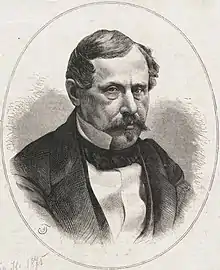Karol Boromeusz Hoffman
Karol Aleksander Boromeusz Hoffman (1798 – 6 July 1875) was a Polish political writer, historian, lawyer and publisher.
Karol Boromeusz Hoffman | |
|---|---|
 | |
| Born | 1798 |
| Died | 6 July 1875 (aged 76–77) |
| Occupation | political writer historian lawyer publisher |
| Spouse(s) | Klementyna née Tańska (m. 1829–1845, her death) |
Biography
From 1828 he was a counselor, and from 1830 one of the directors of Bank Polski.[1] In the years 1828–1830, together with Marceli Tarczewski, he published the legal magazine Themis Polska in Warsaw. In 1829 he married Klementyna Tańska.[1] He participated in the November uprising, and after its fall he settled in Paris in 1832. In the exile, he belonged to Hôtel Lambert, the monarchist conservative-liberal party of Prince Adam Jerzy Czartoryski. From 1837 until 1839 he edited The Chronicle of Polish Emigration. After the death of Klementyna, he married Matylda Dunin-Wąsowicz. In 1848 he moved to Dresden, from where he wrote correspondence to Krakow's daily Time (Czas), and was a member of the Polish Emigration Committee (Komitet Emigracji Polskiej).[1] In 1869 Poznań Society of Friends of Learning awarded him with an honorary membership.[2] From 1873, he was also a correspondent member of the Academy of Learning.[1]
Works
He published works on the November Uprising and a collection of materials about the Great Emigration, especially valued by several historians: Polish Vademecum (1839). In his historical works, he opposed democratic-republican contemporaries. He saw the specifics of the Polish historical process in the underdevelopment of cities and the weakness of royal power.
- Wielki tydzień Polaków (The Great Week of Poles, 1830,[3] new issue 1915,[4][5] translated into German, French and Swedish)
- Rzut oka na stan polityczny Królestwa Polskiego od 1815 do 1830 (A Glance at the Political State of the Kingdom of Poland from 1815 to 1830, 1831)[6]
- Cztery powstania (The Four Insurrections, 1837)
- Król wygnaniec (King of the Exile, about Stanisław Leszczyński, 1854, second edition 1861)
- Historia reform politycznych w dawnej Polsce (The History of Political Reforms in Old Poland, 1867[7] and 1869)
- O panslawizmie zachodnim (On the Western Pan-Slavism, 1868)[8]
- O rządzie skarbu publicznego w dawnej Polsce (On Managing Public Treasury in Old Poland)
- Obraz rządu i prawodawstwa dawnej Polski (An Image of the Government and Legislation of Old Poland)
- Upadek domu Sobieskich (The Fall of the House Sobieski)
- Przyczyny podziału monarchii polskiej po Bolesławie Krzywoustym (The Reasons for the Division of the Polish Monarchy after Bolesław Krzywousty)
Source[9]
References
- Serajski, Marian H. (1961). "Hoffman Karol Boromeusz (1798–1875)". Polski Słownik Biograficzny. IX. pp. 565–566.
- Erzepki, Bolesław (1896). Spis członków Towarzystwa Przyjaciół Nauk w Poznaniu. Poznań. p. 2.
- Hoffman, Karol Boromeusz (1830). "Wielki tydzień Polaków czyli Opis pamiętnych wypadków w Warszawie od dnia 29 listopada do 5 grudnia 1830 r." Warszawa: Polona.pl. Retrieved 22 June 2018.
- Hoffman, Karol Boromeusz (1915). "Wielki tydzień Polaków czyli Opis pamiętnych wypadków w Warszawie od dnia 29 listopada do 5 grudnia 1830 r." Warszawa: Polona.pl. Retrieved 22 June 2018.
- Hoffman, Karol Boromeusz (1915). "Wielki tydzień Polaków czyli Opis pamiętnych wypadków w Warszawie od dnia 29 listopada do 5 grudnia 1830 r." Warszawa: polona.pl. Retrieved 22 June 2018.
- Karol Boromeusz Hoffman (1831). "Rzut oka na stan polityczny Królestwa Polskiego pod panowaniem rossyiskiem przez ciąg lat piętnastu od 1815–1830". Warszawa. polona.pl. Retrieved 22 June 2018.
- Hoffman, Karol Boromeusz (1867). "Historya reform politycznych w dawnej Polsce". Lipsk: Polona.pl. Retrieved 22 June 2018.
- Hoffman, Karol Boromeusz (1868). "O panslawizmie zachodnim. Studium historyczne". Poznań: Polona.pl. Retrieved 22 June 2018.
- "Work of Karol Boromeusz Hoffman digitalized". Polona.pl. Retrieved 23 May 2019.